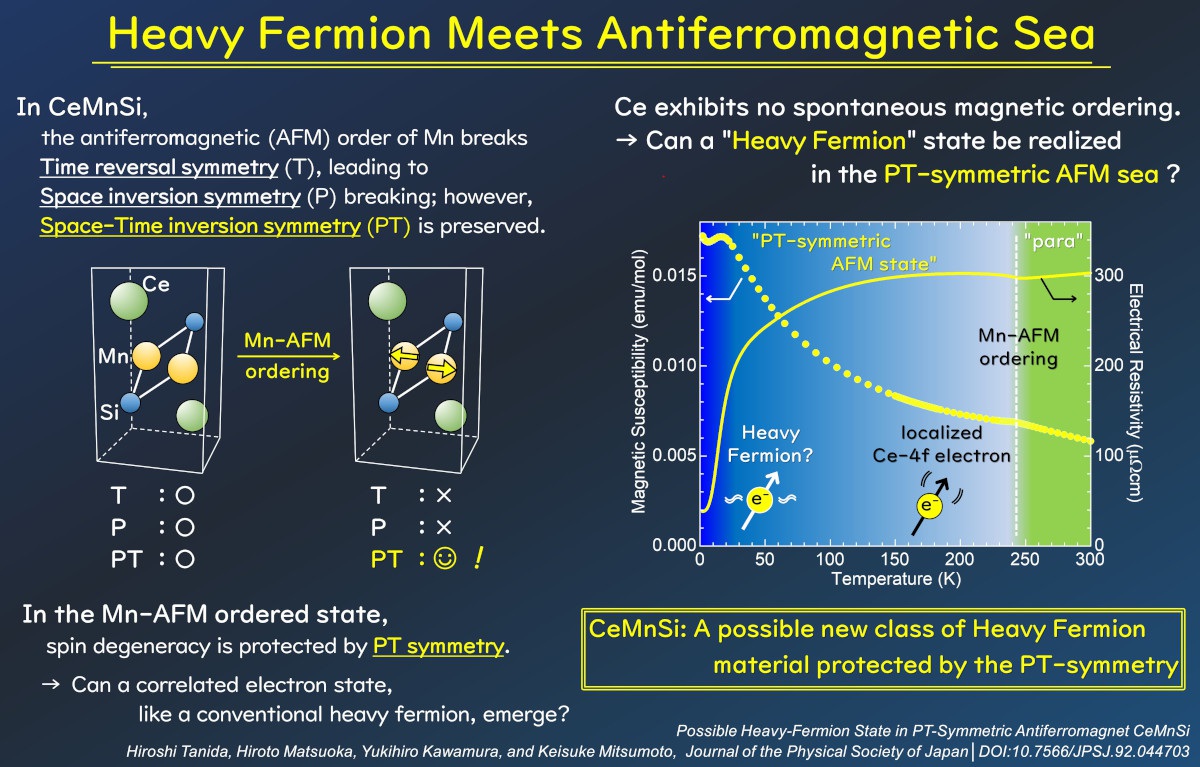Heavy Fermion Meets Antiferromagnetic Sea
© The Physical Society of Japan
This article is on
Possible Heavy-Fermion State in PT-Symmetric Antiferromagnet CeMnSi
(JPSJ Editors' Choice)
J. Phys. Soc. Jpn. 92, 044703 (2023).
CeMnSi exhibits heavy fermion behaviors in an antiferromagnetically ordered state of Mn.
The space-time inversion symmetry inherent in the ordered state is key for the unique electron state.

Symmetries are widespread in nature. For instance, planetary motion is related to the conservation of angular momentum owing to rotational symmetry. In general, symmetries have important implications for physics, and new concepts based on symmetries open up new frontiers of research.
Crystals are one of the research objects in condensed matter physics, and have innumerable atoms arranged periodically with symmetries, including rotation, mirror, and inversion. Space-inversion (P) symmetry is of importance for physical properties; however, it is not always present in crystals. Magnetic ordering, a familiar example of spontaneous symmetry breaking in electron systems, may break P-symmetry depending on the spatial arrangement of electron spins even if the symmetry is innately given. Magnetic ordering itself also breaks time-reversal (T) symmetry owing to the nature of electron spin, as in the Zeeman effect. We investigate how electrons behave in crystal, and thereby know which symmetries are broken.
CeMnSi is a tetragonal intermetallic compound with P-symmetry, and has two magnetic elements: Ce and Mn. The spin degrees of freedom of their unpaired electrons must be frozen at low temperatures in some way according to a thermodynamic requirement. As for Mn, the way is an antiferromagnetic (AFM) ordering with an antiparallel spin arrangement. Consequently, the innate P-symmetry is broken, while the space-time inversion (PT) symmetry, a combination of P and T symmetries, is preserved. Hence, CeMnSi is classified as a PT-symmetric antiferromagnet.
As for Ce, there is no spontaneous magnetic ordering. However, this is not so surprising for Ce-based intermetallics because they have another way for the freezing, the Kondo coupling with conduction electrons. In this case, unpaired Ce-4f electrons become nonmagnetic below a characteristic temperature, and a correlated electron state called the heavy fermion state is realized. The most salient feature of the heavy fermion state in CeMnSi is the presence of the Mn-AFM ordering; heavy fermion states normally appear in paramagnetic state. In other words, CeMnSi provides a place where heavy fermion meets an “AFM sea”. The spin degeneracy protected by the PT-symmetry inherent in the Mn-AFM ordering would be crucial for the unique heavy fermion state in CeMnSi beyond the usual heavy fermion picture. The microscopic mechanisms need to be clarified by theoretical and further experimental studies.
(written by H. Tanida on behalf of all authors.)
Possible Heavy-Fermion State in PT-Symmetric Antiferromagnet CeMnSi
(JPSJ Editors' Choice)
J. Phys. Soc. Jpn. 92, 044703 (2023).
Share this topic
Fields
Related Articles
-
Exploring Electronic States in BEDT-TTF Organic Superconductors
Superconductivity
Electronic transport in condensed matter
Magnetic properties in condensed matter
2024-4-24
This review, published in the Journal of the Physical Society of Japan, provides a comprehensive summary of the electronic states observed in BEDT-TTF type organic superconductors, including metal-insulator transitions, Mottness transitions, non-Fermi liquids, quantum spin liquids, and Bose-Einstein condensation.
-
Variety of Mechanically Induced Spin Currents in Rashba Systems
Electronic transport in condensed matter
Magnetic properties in condensed matter
Structure and mechanical and thermal properties in condensed matter
2024-3-22
Various types of spin currents, including unconventional types, are generated in Rashba spin-orbit coupled systems by dynamic lattice distortions associated with, for example, surface acoustic waves.
-
Current Melt Frozen Electrons
Dielectric, optical, and other properties in condensed matter
Magnetic properties in condensed matter
2024-1-15
The origin of the current-induced insulator-to-metal transition of samarium monosulfide was explained by the 4f−5d hybridization observed using optical reflectivity and photoelectron spectroscopies.
-
Towards Uncovering the Hidden Order of URu2Si2 Phase Transition
Magnetic properties in condensed matter
Electronic structure and electrical properties of surfaces and nanostructures
2024-1-11
We propose a chiral charge as the hidden order parameter in URu2Si2 and present experiments to detect it by focusing on breakings of mirror and inversion symmetries at the local uranium ion.
-
Magnetic Excitation in S = 1/2 Antiferromagnetic Chain CsCoCl3 with Ising-Like Exchange Interaction
Magnetic properties in condensed matter
2023-11-13
The results of high-field electron spin resonance measurements in the millimeter-wave to terahertz region reveal unconventional magnetic excitation in S = 1/2 one-dimensional antiferromagnets.
